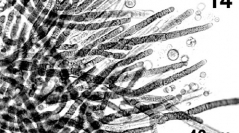

 Cryptogamie, Algologie
24 (3) - Pages 245-267
Cryptogamie, Algologie
24 (3) - Pages 245-267The subaerial algal assemblages of Galway City, western Ireland, were studied by examination of field collections and culture observations; four main types of assemblages were identified. The blue-green assemblage was the most common on stone and cement walls; it was particularly well-developed at sites characterised by poor water drainage. Gloeocapsa alpina and other species of Gloeocapsa with coloured envelopes were the most common forms; Tolypothrix byssoidea and Nostoc microscopicum were also found frequently. The Trentepohlia assemblage occurred also on walls; it was usually produced by large growths of Trentepohlia iolithus, mainly on concrete. Trentepohlia cf. umbrina and Printzina lagenifera were less common and occurred on different substrata. The prasiolalean assemblage was the community usually found at humid sites at the basis of many walls and corners. Rosenvingiella polyrhiza, Prasiola calophylla and Phormidium autumnale were the most common entities; Klebsormidium flaccidum and Prasiola crispa were locally abundant at some sites. The Desmococcus assemblage was represented by green growths at the basis of many trees and electric-light poles and less frequently occurred at the bases of walls. Desmococcus olivaceus was the dominant form, sometimes with Chlorella ellipsoidea. Trebouxia cf. arboricola, Apatococcus lobatus and Trentepohlia abietina were the most common corticolous algae. Fifty-one subaerial algae were recorded; most did not exhibit any obvious substratum preference, the Trentepohliaceae being the only remarkable exception. A comparison with the scanty literature available suggests a general similarity of the composition of the algal assemblages of Galway city with those of other European cities. Distribution patterns and ecological peculiarities of the algal assemblages of Galway are discussed.